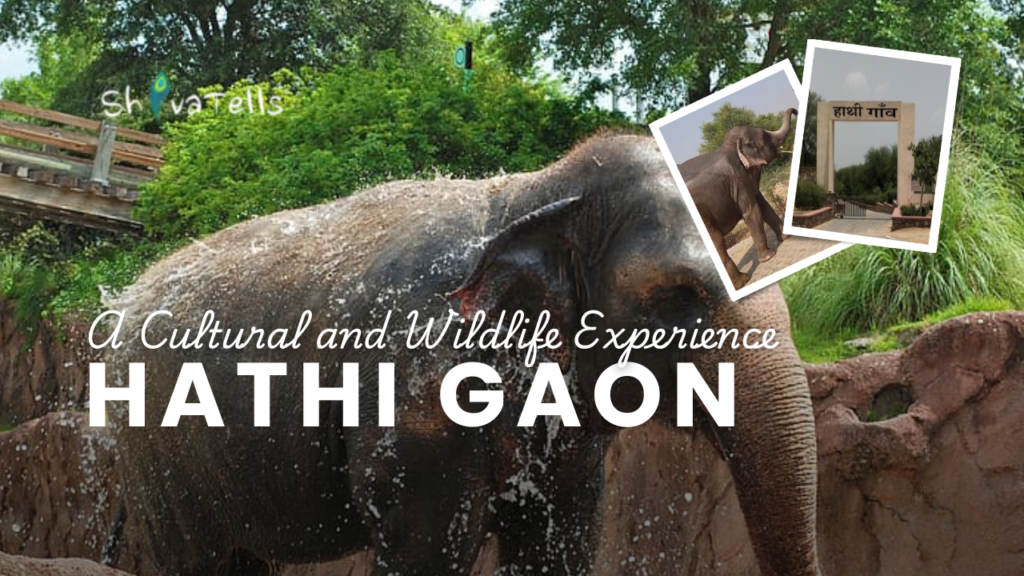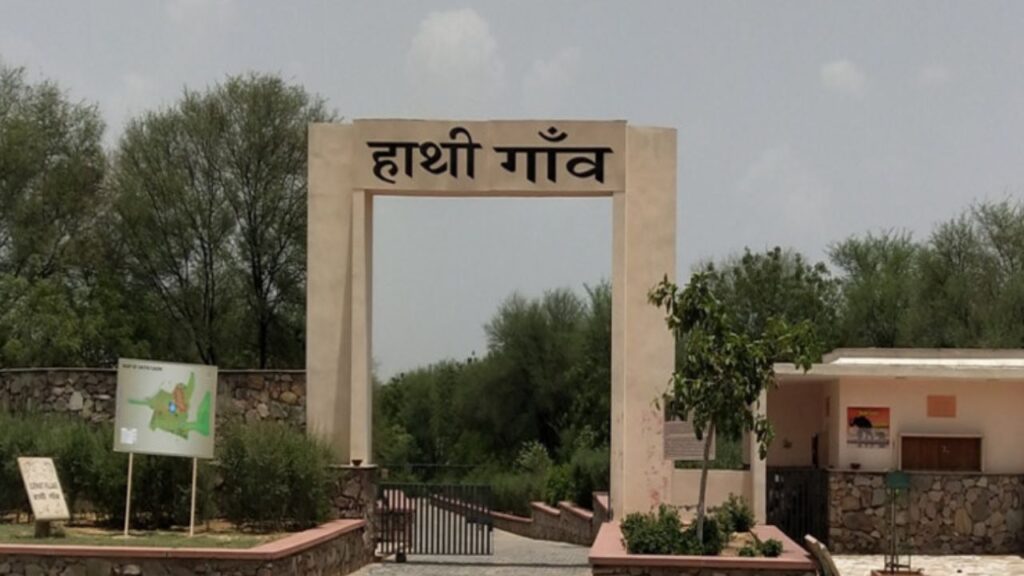In today’s fast-paced world, the lines between cultures are fading, and we are paying a heavy price—our indigenous traditions, folktales, and ancestral wisdom are slowly disappearing. This realization led me to quit my job and take up storytelling as my mission. At ShivaTells, I travel to the remotest corners of India to discover these untold stories and bring them to you. Today, let’s dive into one such fascinating place: Elephant Village, Jaipur, also known as Hathi Gaon.

Table of Contents
Hathi Gaon: Where Elephants and Mahouts Reside

Located near Kunda Amer on NH-248, Elephant Village is spread across 30.5 hectares. This serene village is more than just a tourist spot; it’s a harmonious space where elephants and their mahouts live together, showcasing a unique bond of love and trust.
The Jaipur Development Authority (JDA) handed over the village to the Forest Department in 2017, ensuring the welfare of these gentle giants. Of the 70 specially designed enclosures, 68 have already been allotted, housing over 76 elephants. These enclosures offer comfort and care, complete with three play cottages and a large reservoir where elephants can bathe and play—a sight that’s both heartwarming and unforgettable.
A Day in the Life at Elephant Village
As I walked through the village, the rhythmic sound of bells tied to elephants filled the air. Mahouts lovingly cared for their companions, feeding them fresh sugarcane and bananas. Watching an elephant leisurely bathe in the reservoir was like witnessing a serene dance of nature.
The mahouts shared stories of their ancestral connection with elephants, passed down through generations. Each wrinkle on the elephants’ skin seemed to carry centuries of history, while the eyes of the mahouts reflected a bond that words can’t describe.
Beyond the Elephants: Nearby Places to Visit in Jaipur
Hathi Gaon is undoubtedly a mesmerizing destination, but Jaipur, the Pink City, has so much more to offer! Here’s a detailed guide to nearby places that will complete your trip with a mix of history, culture, and natural beauty:
1. Amer Fort (Amber Fort)

Located just 15 minutes from Elephant Village, Amer Fort is a masterpiece of Rajputana architecture and history. This stunning fort, built with red sandstone and marble, is a UNESCO World Heritage Site.
What to Do:
- On a guided tour, explore the magnificent courtyards, palaces, and the famous Sheesh Mahal (Mirror Palace).
- Witness the spectacular light and sound show in the evening, which narrates the fort’s history.
- Capture the panoramic views of Maota Lake and the surrounding hills.
Fun Tip: You can ride an elephant to the top of the fort or opt for a jeep if you prefer a quicker ride.
2. Jal Mahal

On your way back to the city, stop by Jal Mahal, a stunning palace that appears to float on Man Sagar Lake. This architectural marvel, with its intricate carvings and Rajput-style domes, is a favorite among photographers.
What to Do:
- Take a leisurely stroll along the promenade to enjoy the serene view of the lake.
- Shop for local crafts and jewelry at the stalls nearby.
Fun Tip: Visit during sunrise or sunset for the most magical view.
3. Nahargarh Fort

Located about 30 minutes from Hathi Gaon, Nahargarh Fort sits on the rugged hills of Aravalli, offering a breathtaking panoramic view of Jaipur city.
What to Do:
- Explore the fort’s unique blend of Indian and European architecture.
- Visit Madhavendra Palace, a beautiful complex of interconnected suites.
- Relax with a drink at Padao Café, a rooftop restaurant inside the fort.
Fun Tip: Make it a point to visit during sunset; the view is truly unforgettable.
4. Jaipur Zoo

Located around 25 minutes from Elephant Village, the Jaipur Zoo is another haven for wildlife enthusiasts. Divided into two sections—one for animals and the other for birds and reptiles—the zoo offers a family-friendly outing.
What to Do:
- Spot a variety of exotic and indigenous species of animals, including leopards, alligators, and colorful birds.
- Visit the reptile section to see snakes, crocodiles, and other creatures up close.
Fun Tip: Pair this visit with a trip to Ram Niwas Garden, which is located nearby.
5. City Palace Jaipur

Dive into the heart of Jaipur’s royalty with a visit to the City Palace. Located in the heart of the city, it is a magnificent complex of palaces, courtyards, and museums that showcase the opulence of Jaipur’s royal family.
What to Do:
- Marvel at the intricate architecture of Chandra Mahal and Mubarak Mahal.
- Visit the museum to see royal artifacts, including weapons, costumes, and manuscripts.
- Click photos at the famous Peacock Gate, a symbol of Jaipur’s vibrant art.
Fun Tip: You can book a royal dining experience here for an unforgettable evening.
6. Jantar Mantar

Just a short distance from the City Palace lies the Jantar Mantar, an astronomical wonder and another UNESCO World Heritage Site. Built by Maharaja Sawai Jai Singh II, this site houses the world’s largest stone sundial.
What to Do:
- Learn about the ancient techniques used for timekeeping and astronomical observations.
- Take a guided tour to understand the science behind these instruments.
Fun Tip: Don’t forget to test the accuracy of the sundial—it’s still functional today!
7. Hawa Mahal (Palace of Winds)

Another iconic spot in Jaipur, the Hawa Mahal is located in the bustling Johari Bazaar, just 40 minutes from Hathi Gaon. The palace’s honeycomb design with 953 windows once allowed royal ladies to observe city life without being seen.
What to Do:
- Climb to the top for a stunning view of the city and the market below.
- Shop for jewelry, textiles, and souvenirs at the bazaars nearby.
Fun Tip: Visit early morning to avoid the crowd and capture the best photos.
8. Albert Hall Museum

This stunning Indo-Saracenic structure is one of the oldest museums in Rajasthan. It’s located about 35 minutes from Hathi Gaon, in Ram Niwas Garden.
What to Do:
- Explore exhibits showcasing artifacts, paintings, and sculptures from Rajasthan’s royal history.
- Don’t miss the mummy exhibit, which is a major attraction here.
Fun Tip: The museum looks enchanting when lit up at night—perfect for an evening visit.
Final Thoughts

Jaipur is more than just a city; it’s a living canvas of culture, history, and nature. There’s something here for every traveler, whether it’s the majestic elephants at Hathi Gaon, the regal forts, or the bustling bazaars. So, plan your trip to Elephant Village and explore these nearby gems to experience the best of Jaipur.
Let’s preserve and celebrate these stories together. Follow ShivaTells for more such incredible journeys!
